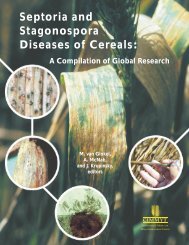Teosinte Distribution in Mexico - CIMMYT: Seeding innovation ...
Teosinte Distribution in Mexico - CIMMYT: Seeding innovation ...
Teosinte Distribution in Mexico - CIMMYT: Seeding innovation ...
Create successful ePaper yourself
Turn your PDF publications into a flip-book with our unique Google optimized e-Paper software.
J. Jesús Sánchez and José Ariel Ruiz Corral<br />
teos<strong>in</strong>te <strong>in</strong> the face of the above is its use as a fodder,<br />
its flexibility <strong>in</strong> occupy<strong>in</strong>g open niches, its usefulness<br />
<strong>in</strong> the improvement of native varieties, and <strong>in</strong> some<br />
cases its revered status as the “heart” of maize,<br />
among certa<strong>in</strong> ethnic groups (Hernández X. 1993).<br />
Geographic studies, monitor<strong>in</strong>g, exploration,<br />
collection, and conservation of teos<strong>in</strong>te populations<br />
are activities that must be <strong>in</strong>tensified to reduce the<br />
danger of their disappear<strong>in</strong>g. The potential for<br />
discover<strong>in</strong>g new variants with still unknown genetic<br />
properties for use <strong>in</strong> crop improvement programs<br />
fully justifies teos<strong>in</strong>te preservation efforts.<br />
References<br />
Benz, B.F., L.R. Sánchez V., and F.J. Santana M. 1990. Ecology<br />
and ethnobotany of Zea diploperennis: prelim<strong>in</strong>ary<br />
<strong>in</strong>vestigations. Maydica 35: 85-98.<br />
Bukasov, S. 1926. Un híbrido de maíz y Euchlaena mexicana.<br />
Offpr<strong>in</strong>t from México Forestal. p. 38.<br />
Coll<strong>in</strong>s, G.N. 1921. <strong>Teos<strong>in</strong>te</strong> <strong>in</strong> <strong>Mexico</strong>. J Hered 12: 339-350.<br />
Doebley, J.F. 1983. A brief note on the rediscovery of Durango<br />
teos<strong>in</strong>te. Maize Genetics Cooperation Newsletter 57: 127-<br />
128.<br />
Doebley, J.F. 1990a. Molecular evidence and the evolution of<br />
maize. Econ Bot 44: 6-27.<br />
Doebley, J.F. 1990b. Molecular evidence for gene flow among<br />
Zea species. BioScience 40: 443-448.<br />
García, E. 1973. Modificaciones al sistema de clasificación<br />
climática de Köppen. UNAM. Instituto de Geografía.<br />
246p.<br />
Guzmán M., R. 1982. El teoc<strong>in</strong>tle en Jalisco: Su distribución y<br />
ecología. B. S. thesis, Escuela de Agricultura (School of<br />
Agriculture), Universidad de Guadalajara (University of<br />
Guadalajara). 88p.<br />
Hernández X., E. 1987. Experiences lead<strong>in</strong>g to a greater<br />
emphasis on man <strong>in</strong> ethnobotanical studies. Econ Bot 41: 6-<br />
11.<br />
Hernández X., E. 1993. La agricultura tradicional como una<br />
forma de conservar el germoplasma de los cultivos <strong>in</strong> situ.<br />
pp. 243-256 In: B.F. Benz (compiler), Biología, ecología y<br />
conservación del género Zea. Universidad de Guadalajara.<br />
Kato Y., T.A. 1976. Cytological studies of maize (Zea mays L.)<br />
and teos<strong>in</strong>te (Zea mexicana Schrader Kuntze) <strong>in</strong> relation to<br />
their orig<strong>in</strong> and evolution. Mass. Agr. Exper. Stat. Bull.<br />
635. 186p.<br />
Kato Y., T.A. 1984. Chromosome morphology and the orig<strong>in</strong> of<br />
maize and its races. Evol Biol 17: 219-253.<br />
Lipp, F.J. 1986. The plant domestication process among<br />
swidden agriculturalists. Paper presented at the 27th<br />
Annual Meet<strong>in</strong>gs of the Society for Economic Botany, New<br />
York Botanical Garden, Bronx, New York. June 13-16, 1986.<br />
35<br />
López y Parra, R. 1908. El teoz<strong>in</strong>tle. Orígen del maíz. Secretaría<br />
de Fomento, <strong>Mexico</strong>.<br />
Lumholtz, C. 1902. Unknown <strong>Mexico</strong>, Vol. 1. C. New York:<br />
Scribner’s Sons. p. 429.<br />
Mangelsdorf, P.C. 1974. Corn. Its orig<strong>in</strong>, evolution and<br />
improvement. Belknap Press. Harvard University Press.<br />
Cambridge, Mass. 262p.<br />
Mangelsdorf, P.C., and R.G. Reeves. 1959. The orig<strong>in</strong> of corn.<br />
III. Modern races, the product of teos<strong>in</strong>te <strong>in</strong>trogression.<br />
Botanical Museum Leaflet, Harvard University. 18: 389-<br />
411.<br />
Mangelsdorf, P.C. 1986. The orig<strong>in</strong> of corn. Sci Am 25(2): 80-86.<br />
Rzedowski, J. 1993. Diversity and orig<strong>in</strong>s of the phanerogamic<br />
flora of <strong>Mexico</strong>. pp. 129-143. In: T.P. Raammoorthy, R. Bye,<br />
A. Lot and J. Fa. Biological Diversity of <strong>Mexico</strong>, Orig<strong>in</strong>s and<br />
<strong>Distribution</strong>. Oxford Univ. Press.<br />
Sánchez G., J.J., and L. Ordaz S. 1987. Systematic and<br />
Ecogeographic Studies on Crop Genepools: 2. El teoc<strong>in</strong>tle<br />
en México. Distribución y situación actual de las<br />
poblaciones. IBPGR, Rome. 50p.<br />
Sánchez G., J.J., and M. Chuela B. 1995. Monitoreo y<br />
recolección de teoc<strong>in</strong>tle en México. Unpublished research<br />
report. Campo Experimental Centro de Jalisco (Experimental<br />
Field Center of Jalisco), CIPAC, INIFAP.<br />
Sánchez-Velásquez, L., J.A. Solís M., E. Cortés, R.G. Jiménez G.,<br />
A.L. Cárdenas T., and M.P. Rosales A. 1991. Efecto del<br />
cultivo tradicional del maíz sobre el crecimiento y<br />
desarrollo de Zea diploperennis. BIOTAM 3: 51-58.<br />
Wellhausen, E.J., L.M. Roberts, and E. Hernández X., with the<br />
collaboration of P.C. Mangelsdorf. 1951. Razas de Maíz en<br />
México. Folleto Técnico No. 5. Ofic<strong>in</strong>a de Estudios<br />
Especiales. S.A.G. México. 237p.<br />
Wilkes, H.G. 1967. <strong>Teos<strong>in</strong>te</strong>: the closest relative of maize.<br />
Cambridge, Massachusetts: The Bussey Institute, Harvard<br />
University. 159p.<br />
Wilkes, H.G. 1970. <strong>Teos<strong>in</strong>te</strong> <strong>in</strong>trogression <strong>in</strong> the maize of the<br />
Nobogame Valley. Botanical Museum Leaflet, Harvard<br />
University. 22: 297-311.<br />
Wilkes, H.G. 1977a. Hybridization of maize and teos<strong>in</strong>te <strong>in</strong><br />
<strong>Mexico</strong> and Guatemala and the improvement of maize.<br />
Econ Bot 31: 254-293.<br />
Wilkes, H.G. 1977b. The orig<strong>in</strong> of corn. Studies of the last<br />
hundred years. pp. 211-223. In D.S. Seigler (ed.), Crop<br />
Resources. Academic Press, Inc.<br />
Wilkes, H.G. 1979. <strong>Mexico</strong> and Central America as a Center for<br />
the orig<strong>in</strong> of agriculture and the evolution of maize. Crop<br />
Improv 6: 1-18.<br />
Wilkes, H.G. 1985. <strong>Teos<strong>in</strong>te</strong>: the closest relative of maize<br />
revisited. Maydica 30(2): 209-223.<br />
Wilkes, H.G. 1986. <strong>Teos<strong>in</strong>te</strong> <strong>in</strong> Oaxaca, <strong>Mexico</strong>. Genet. Coop.<br />
News 60: 29-30.<br />
Wilkes, H.G. and S. Taba. 1993. <strong>Teos<strong>in</strong>te</strong> <strong>in</strong> the Valley of Toluca,<br />
<strong>Mexico</strong>. Maize Genet. Coop. News. 67: 21.









